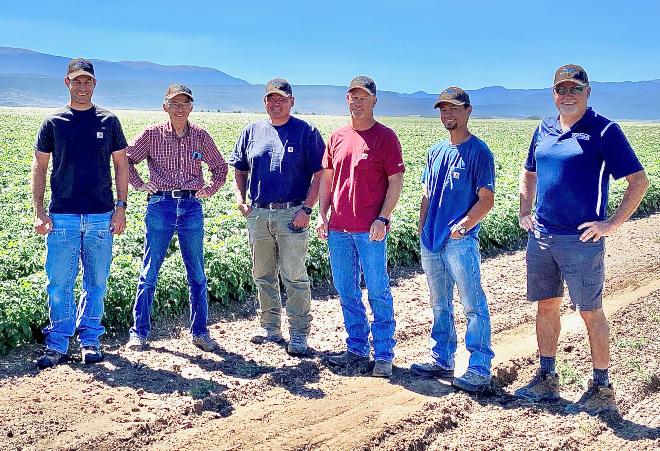
San Luis Valley farms come together to expand seed potato production with San Acacio Seed
Geographic isolation in farming isn’t a bad thing when it comes to keeping disease out of your fields and improving quality. The three farms that make up the San Acacio Seed partnership definitely see it as a positive.
Three potato farms in Colorado’s San Luis Valley formed San Acacio Seed in 2016 as a way to specialize and, ultimately, increase their production. The partners include seed farms Price Farms and Salazar Farms and commercial farm Three S Ranch. San Acacio Seed, which is managed by young couple Braydon and Amanda Wakasugi, sometimes collaborates with Caldon Commodities to diversify rotations.
The partnership works through isolated specialization in growing early or late field years of the seed production cycle prior to seed being made available to commercial growers. Salazar Farm, for example, often focuses on first- and second-year seed potatoes before sending them to the San Acacio for later field years.
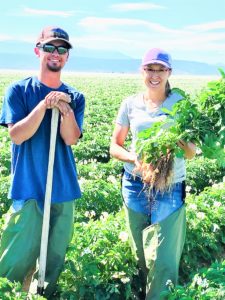
Increased production was a key for the partnership, but only under the premise of staying isolated to keep the seed clean. The San Acacio fields are located near the New Mexico border.
“We have about 30 to 60 miles between us and the nearest commercial farm up in the main part of the Valley,” Amanda Wakasugi said. “All of our prevailing winds come off the prairie, so we don’t have any potato regions around us that blow into our growing area. We have physical barriers as well. There are mesas and hills that completely separate us and the vast amounts of desert between us and the nearest commercial potato farm.”
Braydon Wakasugi started farming at age 12 with his grandfather and co-founder of Three S Ranch, Rodger Wakasugi. The experience inspired Braydon to stay with agriculture.
“During the summer, he’d pick me up before the sun came up and we’d go work all day,” Braydon Wakasugi said. “It just grew on me and I knew I wanted to follow in his footsteps.”
The San Acacio partnership allowed Braydon to transition to a leadership role on the new farm. Amanda was hired to handle the administration side of things, which is how the two met. Amanda, a native of New Mexico, did not grow up on a farm, but began working in the potato crop production in 2011 and made frequent trips to the San Luis Valley for crop-related business.
“I just fell in love with the Valley and the people here and love working with potatoes,” she said. “The seed industry is a different ballgame, but it’s a challenge that we meet every day.”
Growing in the Valley
The San Luis Valley, while technically a valley because it is surrounded by highlands, is still more than a mile above sea level. Salazar Farms, owned and operated by LeRoy Salazar, is at 7,700 feet. The elevation makes for cool summer nights and a short-but-good growing season for potatoes. Planting is between April 25 and May 10 and harvest is done by the second week of October, if not the first week. Frost-free days can dip below 90 some years, Salazar said.
“The climate really is ideal,” he said. “We don’t have many disease issues. We’ve had very few cases of late blight, whereas other areas can struggle with that. Because of cold winters — and it does get cold — we don’t end up developing huge nematode problems or other problems that some other areas have.”
RELATED: More with LeRoy Salazar
Salazar, a fifth-generation farmer whose family roots in the Southwest go back hundreds of years, worked as a researcher and Extension specialist for Colorado State University in the late 1970s. While employed there, he spent two years in Peru — where potatoes originated — working near the International Potato Center. Salazar said the conditions in the San Luis Valley are close to the highlands of Peru.
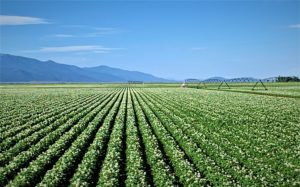
“I think our summers are similar to South America where I was working, at 11,000 feet,” he said. “They can grow them for a longer season because they’re closer to the equator, but it’s fairly similar.”
Amanda Wakasugi said soil in the San Luis Valley varies greatly. “Down here at San Acacio, we have extremely heavy, loamy-type soil in some of our fields, but then we have a couple fields that are clay and clod-like, as well as rocky. It just really depends on where you’re at in the Valley. Some of our commercial growers are blessed with really sandy soil, for example.”
San Acacio Seed grows a variety of cultivars, including reds, yellows and russets.
“If you look at yellow varieties, our favorite right now is the Soraya because it’s very water efficient, nutrient efficient and it is pretty disease resistant,” Salazar said. “It grows fast and has good yields.”
Modoc, Ciklamen and Mozart are among their red varieties, although Salazar said he’s on the lookout for a red that keeps its color in storage and has good dormancy characteristics.
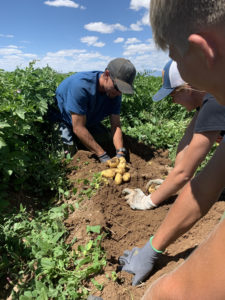
“The Modoc has a really nice color and it holds in storage pretty well and we get pretty decent yields, but the issue with it is that it’s a weak plant. You get a hail storm or something like that and then you’ve got some issues,” Salazar added. “It’s just not as vigorous as the Soraya.”
Several types of Russet Norkotahs are grown for tablestock, including the Colorado 3 and 8 varieties, as well as the Texas 278 and 296. The Reveille russet is gaining popularity as well, although its maturation cycle isn’t fast enough to get optimal seed yields in a short seed-growing season.
“We’re looking for a really fast-growing, 90-day russet that has a good yield and sets a good skin and stores well,” said Salazar, before adding wistfully: “But we’re all looking for that magic variety. … That’s a continual search.”
The future
Like farmers just about anywhere in the U.S., labor is an ongoing concern. Amanda was a product of an agricultural development program, which the team at San Acacio is hoping to develop through a new internship program, which it started this year.
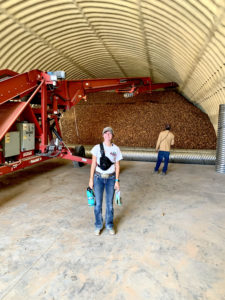
“We had our first intern this year, Jenna, and I hope it was a positive experience for her,” Amanda Wakasgui said. “I hope we can offer that to other students in the Valley and get kids to focus on their ag community while helping them toward their educational goals.”
Wakasugi said goals for San Acacio Seed include adding a greenhouse and possibly adding varieties for areas of the industry beyond tablestock, like chipping.
“I think we envision our farm to be a one-stop-shop farm on day,” she said. “The sky’s the limit, but it all comes back to basic necessities, like water, land and labor. Those factors are always going to come into play.
“We hope to continue to move forward in a positive direction.”
For more with Braydon and Amanda Wakasugi, check out Episode 2 of Spudman’s new podcast, “The Potato Field.”
Top photo: From left, San Acacio Seed partnership farm partners Jared Smith, Three S Ranch; LeRoy Salazar, Salazar Farms; Cole Wakasugi, Three S Ranch; Monty Smith, Three S Ranch; Braydon Wakasugi, San Acacio Seed; and Kent Price, Price Farms.














